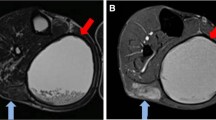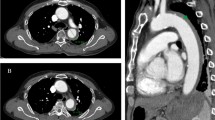Abstract
Chronic expanding hematoma is a rare presentation of a hematoma characterized by a persistent increase in size for more than a month after the initial hemorrhage. We present a 65-year-old man with a chronic expanding hematoma in his ilium who was receiving anticoagulant treatment. The patient had a delayed manifestation of a femoral neuropathy with massive bone destruction. 2-Deoxy-[18F]fluoro-d-glucose (FDG) positron emission tomography (PET) imaging revealed an increased uptake in the rim of the mass in images acquired 1 h after FDG injection. FDG-PET scans were performed using a dedicated PET scanner (HeadtomeV/SET2400 W, Shimadzu, Kyoto, Japan), and the PET data for the most metabolically active region of interest (ROI) were analyzed. The maximum standardized uptake value (SUVmax) was set to a cut-off point of 3.0 to distinguish between benign and malignant lesions. The SUVmax of the patient’s lesion was 3.10, suggesting a malignant lesion. The characteristics of FDG-PET images of chronic expanding hematomas, including the uptake of FDG in the peripheral rim of the mass as a result of inflammation, should be recognized as a potential interpretive pitfall in mimicking a sarcoma.




Similar content being viewed by others
References
Reid JD, Kommareddi S. Chronic expanding hematomas: a clinico-pathologic entity. JAMA 1980; 244:2441–2442.
Lewis VL Jr, Johnson PE. Chronic expanding hematoma. Plast Reconstr Surg 1987; 79:465–467.
Aoki T, Nakata H, et al. The radiological findings in chronic expanding hematoma. Skeletal Radiol 1999; 28:396–401.
Lodge MA, Lucas JD, Marsden PK, et al. A PET study of18FDG uptake in soft tissue masses. Eur J Nucl Med 1999; 26:22–30.
Schulte M, Brecht-Krauss D, Heymer B, et al. Fluorodeoxyglucose positron emission tomography of soft tissue tumours: is a non-invasive determination of biological activity possible? Eur J Nucl Med 1999; 26:599–605.
Strauss LG, Conti PS. The applications of PET in clinical oncology. J Nucl Med 1991; 32:623–648.
Feldman F, van Heertum R, Manos C.18FDG PET scanning of benign and malignant musculoskeletal lesions. Skeletal Radiol 2003; 32:201–208.
Aoki J, Watanabe H, Shinozaki T, et al. FDG PET of primary benign and malignant bone tumors: standardized uptake value in 52 lesions. Radiology 2001; 219:774–777.
Aoki J, Watanabe H, Shinozaki T, et al. FDG-PET for preoperative differential diagnosis between benign and malignant soft tissue masses. Skeletal Radiol 2003; 32:133–138.
Schulte M, Brecht-Krauss D, Heymer B, et al. Grading of tumors and tumorlike lesions of bone: evaluation by FDG PET. J Nucl Med 2000; 41:1695–1701.
Beckers C, Ribbens C, Andre B, et al. Assessment of disease activity in rheumatoid arthritis with (18)F-FDG PET. J Nucl Med 2004; 45:956-964.
Gihlmann A, Brechy-Krauss D, Suger G, et al. Chronic osteomyelitis: detection with FDG PET and correlation with histopathologic findings. Radiology 1998; 206:749–754.
Kubota R, Yamada S, Kubota K, et al. Intratumoral distribution of fluorine-18-fluorodeoxyglucose in vivo: high accumulation in macrophages and granulation tissues studied by microautoradiography. J Nucl Med 1992; 33:1972–1980.
Imaizumi S, Morita T, Ogose A, et al. Soft tissue sarcoma mimicking chronic hematoma: value of magnetic resonance imaging in differential diagnosis. J Orthop Sci 2002; 7:33–37.
Sreenivas M, Nihal A, Ettles DF. Chronic haematoma or soft-tissue neoplasm? A diagnostic dilemma. Arch Orthop Trauma Surg 2004; 124:495–497.
Bush CH. The magnetic resonance imaging of musculoskeletal hemorrhage. Skeletal Radiol 2000; 29:1–9.
Kelm J, Ahlhelm F, Engel C, et al. Synovial sarcoma diagnosed after a sports injury. Am J Sports Med 2001; 29:367–369.
Dethy S, Goldman S, Blecic S, et al. Carbon-11-methionine and fluorine-18-FDG PET study in brain hematoma. J Nucl Med 1994; 35:1162–1166.
Acknowledgements
The authors thank Mr. Y. Nakamura and the staff of the Department of Nuclear Medicine and the Cyclotron staff of Osaka University Medical School Hospital for their technical support in performing the studies, as well as Ms. M. Sudo and K. Tsunoda for their administrative assistance.
Author information
Authors and Affiliations
Corresponding author
Rights and permissions
About this article
Cite this article
Hamada, K., Myoui, A., Ueda, T. et al. FDG-PET imaging for chronic expanding hematoma in pelvis with massive bone destruction. Skeletal Radiol 34, 807–811 (2005). https://doi.org/10.1007/s00256-005-0895-x
Received:
Revised:
Accepted:
Published:
Issue Date:
DOI: https://doi.org/10.1007/s00256-005-0895-x




